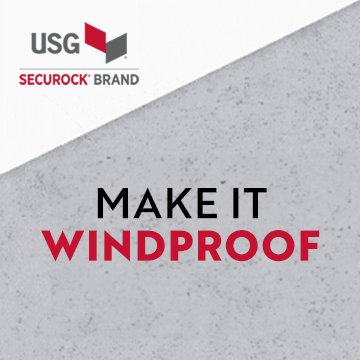Underlayment
« Back To Roofers TalkEric, another thoughtful post (so what else is new ;) )
My practice is informed by the local conditions. The hardest part for most roofs in our environment, is the late winter/early spring time when the snowfall is ample, the temperature swings between about -10/15C to 0/5C happen almost daily, with consequent melting and refreezing. Under those conditions, ice dams form even on well insulated and well-ventilated roofs. If the appropriate underlayment is not in place under the shingles and the flashings, you will (not may, but will) get water infiltration and leakage.
In response to these conditions, much of the local trade uses Grace I&W as the panacea - stick it on, and the problem is gone. Sure it is. Until it doesn't work, and then everyone scratches their heads and behinds and wonder why the miracle didn't happen this time. As you pointed out, Eric, leaks happen in sidelaps, and in other places, and rarely due to penetration due to nail-holes. Peel and stick membranes do not adhere well to masonry, or metal, and those surfaces need to be primed with roofing cement or similar material to ensure adhesion and water-proof installation. Which most do not bother to do (ick - it's messy! It slows down the "flow"!). So it's not enough to use the right materials, then have to be used in the right way.
When we were doing shingle work our code called for 2 layers of 15# lapped shingle style or 30#, we used 30# and sometimes roofers base sheet 45# on metal 30# fit the scope in certain areas we used what ever the code called for we always chose the better felts, on tile roofing depending on how it was set, mainly 30-90 foam and mortar special nailing for the latest FBC building codes, valleys were treated different by using additional felts and metal ferrous and non ferroius. Our fastening was based on wind loads which ranged fro 100mph to 160mph. Lots of funny rules and regulations here in the sunshine state lol
Very nice to see you showing up here at the old watering hole, pgriz. It's been a long time since I've heard from you on the forum, but not a long time at all since I've thought of you and wondered how you are doing.
This whole underlayment issue has interested me for decades. Here's my present sense of it in a rambling form.
Back in the seventies, I had a signed letter from Certainteed stating that no underlayment was required under their shingles. I was doing tract work at the time and tried it on a couple of houses but the public reaction was far too negative so I immediately dropped it. Tract work has to be bid too tight anyway, so by the early eighties I was done with it anyway. A system without underlayment at all signifies the extreme end of the spectrum.
You are right about all the holes, of course, but, in fact, over the past forty years I have carefully observed that when water does get beneath the primary surface and gets to the underlayment, it generally does not leak through fastener penetration locations. It usually finds a side lap or a gross defect in the underlayment, or dives in at an opening created for a major event like a skylight, mechanical jack, or something of like nature. That is until the fastener heads disintegrate. Then, it is like Mercutio said, "... 'tis not so deep as a well, nor so wide as achurch-door; but 'tis enough,'twill serve."
It is for that reason I want better fasteners. Leaving aside the issue of ice dams, which require special treatment anyway, I have gone back to preferring asphalt felts as underlayments, with some very large exceptions, because they are cheaper and they have very much better traction in cold weather or moist circumstances. #30 for steeper pitches make for a very safe work site. But if they are exposed to chronic moisture, they rot. That's a big deal. Synthetics don't rot. Roofer Select is an asphalt underlayment that gets part of the way there and also doesn't pucker and telegraph much. In the right special circumstances, I use that.
As OS states, synthetics can also handle varying degrees of weather over time, and they don't blow away in high wind. That can be a huge factor. They are longer rolls and lighter rolls, 'tis true, but if standard underlayments are well-made, properly shipped, and properly stored, they net out to me as more manageable to install. I do get tired of bogus claims by manufacturers about "labor savings." Labor savings mean that when all is said and done, the job is clean, right, and timely, and less exhausting. Day in/day out, that is what counts. On a cool day, #15 is great. On a hot day it isn't, especially if it's oily.
My favorite synthetic is Deck Armor. It breathes, it's stronger than hell, it's not nearly as squirmy (time for daddybob to check back in) as the other synthetics. It's pricey and lacks reliable markings for a proper two-ply lay-up. Macroofer once blared that it was the only underlayment he uses which almost enticed me to stop using it myself. But I didn't and it's certainly not the only underlayment I use.
Sometimes you have to use S/A underlayments. OS is right again about covering them to prevent fusion to your primary material. I prefer the Grace Ultra to any of the others, but it's often too expensive for a given project. I like all Grace products with the possible exception of the Plus which I have no occasion to use. But I think there are lots of good S/A membranes now. Most of them have more user-friendly release systems than the Grace does. If I'm using Grace, I usually prime first.
On shakes I still use #30. On tile it varies. A heavier SBS works very well (although in hot weather it'll smoke your hands just touching it during lay-up) and unless it's a low slope or leaf-catching area, or down near perimeters, I don't use S/A. Not only don't, but won't. It's an ugly, gooey, labor intensive mess in the broad field. Totally unnecessary and in my humble opinion a dumb idea. Like Tinner says, it will be long gone in a hundred years anyway. On the other hand, OS posted pics of a tile job he and his boys did that utilized S/A with a synthetic cover. I am more than willing to admit that as steep as the job was, as difficult to get back to after the staging is down, it was more than justified and will be a first-rate back up to the tile for decades. It will also minimize migration of leaks under the underlayment (which is the principal reason that I prime)
One size definitely does not fit all. Choices make it all worthwhile.
Most of the time, we're installing metal (aluminum shingles, metal shingles, vertical panels) with occasional fiberglas asphalt shingles. On eaves, valleys, endwalls and the like we use either Grace I&W or Titanium PSU. On the rest, we install either Titanium UDL-30 or 50. On mansard walls we'll install #15 felt, unless there is prior experience of water infiltration, in which case we'll use either the synthetic underlayment or the membranes. To my mind, the additional cost of the more expensive stuff is peanuts compared to the cost of fixing or re-doing the roof. And most of the time, the customers come to us after being unsatisfied by cheaper attempts. So when it gets to us, it better work.
Our required underlayment is 30# rag felt or 2 layers of 15# However we usually up grade the material and use SA SBS we find that this is a suitable item.
50 degrees and morning dew will do the trick just fine. Working from 11:00 to dark is a pleasant day, but we can't always manage to keep it in those parameters. Fuzzyman is a lot more user-friendly.>>>
Don't install when raining. Good Idea for all kinds of roofs>>>
Hello, bit new to the forum:
Are you guys using Titanium UDL 25, 30, or 50?
My other question, is w/ Shingles going up 40% in NY what do you guys now charge a Square?>>>
I use a lot of synthetics. I also use organic felts. Actually I can think of different situations that scream out for different felts. One thing I have to say is that synthetics (not to be confused with peel and stick HDPE film sheets w/modified asphal>>>
I've always admired your intelligence RScape>>>
Thats a good point Kenny Rogers... I mean Macroof. :laugh:
Not to mention it's most desirable factor during installation, it can start pouring during the installation and a synthetic will look at the water and laugh. In all reality, you could leave a h>>>
The right synthetic underlayment is just a better product than felt paper. Not only is it safer to walk on, but it provides far better protection should something happen and shingles come off. The type we use breaths, and, unlike felts, it will not brea>>>
Around DC we have crazy hills. The houses and town houses can be two stories in the front and four in the back. So on long runs and high foot traffic jobs, I like to use synthetic in addition to a roof jack on the bottom. I respect the roof and believe in>>>
There's an old saying that says "leave well enough alone". And I truly believe in that. Felt has been used for well over 100 years. It's a good vapor barrier. Do I need to use anything else? No. But some situations just have synthetic written all ove>>>
I still use tar paper,30 lb. We cover what we tear immediately and I have been thinking about switching to 15 lb. to be more cost effective.Does anyone have any thoughts on this? What are your reasons for using the synthetics? I see them advertised in all>>>






















